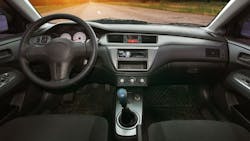Driverless Cars: Can We Accurately Regulate an Emerging Technology?
Dan Lipinski, a U.S. Representative for Illinois’ 3rd congressional district and vocal voice for cybersecurity in transportation systems, delivered the keynote address at the recent Empire State of Mobility Conference. Lipinski, who serves on two House Committees—Transportation & Infrastructure, and Science, Space, & Technology—underscored the advantages of new mobility technologies during his presentation (Fig. 1).
Much of the address focused on the benefits of driverless-car technology for our society and how new modes of mobility will transform the transportation system. He also emphasized the need for appropriate federal regulations, noting that they could safely speed up the rollout of this emerging technology.
1. Illinois Congressman Dan Lipinski delivers his keynote at The Empire State of Mobility Conference.
Proponents of driverless-vehicle technology say that such vehicles will likely improve road safety, as most accidents result from human driver errors. They also point out that driverless cars have the potential to reduce traffic congestion while cutting pollution. These cars could even improve the mobility of the elderly and people with some kind of physical impairment.
Getting More Connected
To maximize the efficiency of driverless cars, Congressman Lipinski emphasized the importance of car connectivity. Car connectivity is expanding and at the same time changing the concept of mobility. New mobility behaviors like ride sharing are growing with companies like Uber, Lift, Car2Go, and Zipcar. With driverless cars, user behavior will change even more dramatically.
Rapid changes also are being seen in the automotive market, as technology advances bring sophisticated connectivity and safety features to a wider array of cars. Consequently, the driving experience will, in a not-too-distant future, reach a level where paying attention to the road or holding the steering wheel will not be required. For me personally, it’s still hard to imagine that not knowing how to drive a car won’t be an obstacle to “driving” that car.
The faster pace of the technology is evidenced by several U.S. companies announcing that they expect to debut fully automated (driverless) vehicles by the late 2020s (Ford is one example). But I don’t think we will have “Level 5” (Fig. 2) driverless cars cruising the streets in the near future, because the technology is not yet on track. In addition, costs are still extremely high and regulations lack clarity at this point.
2. This chart depicts the levels of automation for self-driving cars. (Courtesy of Self-Driving Coalition for Safer Streets)
Regulatory Jumble
Although many driverless car companies have tested their driverless cars on public roads, they’re experiencing delays because of both technology challenges and regulatory issues. Just recently, Michigan became the first state to establish regulations for the testing, use, and eventual sale of self-driving cars. But should the state regulate the adoption of such a disruptive technology? Or should it be the federal government in order to avoid a state-to-state approach that could slow down technology development?
The U.S. Department of Transportation (DOT) recently released guidelines for autonomous vehicles, but it’s still unknown how the DOT is going to implement them. For example, the DOT recommends that states be responsible for licensing human drivers, enforcing traffic laws, and establishing requirements for autonomous vehicle testing on public roads. For its part, the federal government should have primary control over the actual automation software and handling recalls.
I agree with Congressman Lipinski when he says that America needs better guidance from the federal government so as to not delay these advances. The U.S. should be a leader of the driverless car market by maintaining a balance between safety and innovation. Driverless-car technologies are disrupting multiple aspects of our society. As such, their rollout demands careful study and the participation of both the private and the public sector.
About the Author
Maria Guerra Blog
Power/Analog Editor
Maria Guerra is the Power/Analog Editor for Electronic Design. She is an Electrical Engineer with an MSEE from NYU Tandon School of Engineering. She has a very solid engineering background and extensive experience with technical documentation and writing. Before joining Electronic Design, she was an Electrical Engineer for Kellogg, Brown & Root Ltd (London. U.K.). During her years in the Oil and Gas Industry she was involved in a range of projects for both offshore and onshore designs. Her technical and soft skills bring a practical, hands-on approach to the Electronic Design team.



